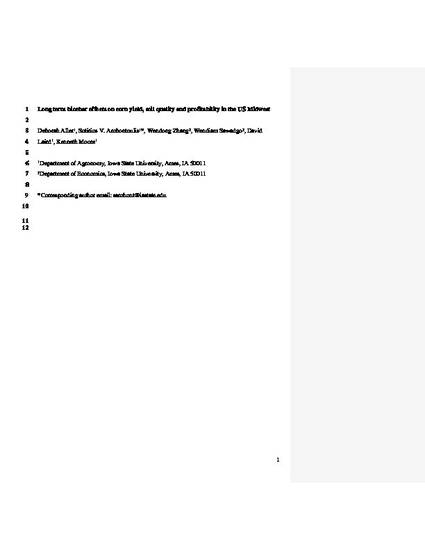
Corn production in the US Midwest has the potential to generate a large amount of crop residue for bioenergy production. However, unconstrained harvesting of crop residues is associated with a long-term decline in soil quality. Biochar applications can mitigate many of the negative effects of residue removal but data and economic analyses to support decision making are lacking. To explore sustainable and profitable practices for residue harvesting in central Iowa we used 11 years of soil, crop yield, and management data to calibrate the Agricultural Production Systems sIMulator (APSIM) biochar model. We then used the model to evaluate how different biochar types and application rates impact productivity and environmental performance of conventional corn and corn-soybean cropping systems in Iowa under different N fertilizer application rates and residue harvesting scenarios. A cost-benefit analysis was also employed to identify the economically optimal biochar application rate from both producer and societal perspectives. Modeling results showed for both continuous corn and corn-soybean rotations that as biochar application rate increased (from 0 to 90 Mg ha-1) nitrate leaching decreased (from 2.5 to 20 %) and soil carbon levels increased (from 8 to 115 %), but there was only a small impact on corn yields (from –2.6 to 0.6 %). The cost-benefit analysis revealed that public benefits, evaluated from decreased nitrate leaching and increased soil carbon levels, significantly outweighed the private revenue accrued from crop yield gains, and that a biochar application rate of 22 Mg ha-1 was more cost-effective (per ton) compared to higher biochar rates. Overall, this study found that applying biochar once at a rate of 22 Mg ha-1 allows for the sustainable annual removal of 50% of corn residue for 32 years, is profitable for farmers even with minimal impact on grain yield, and beneficial to society through reduced nitrate leaching and increased soil organic carbon levels.
Available at: http://works.bepress.com/wendong_zhang/95/

This is a manuscript of an article published as Aller, Deborah M., Sotirios V. Archontoulis, Wendong Zhang, Wendiam Sawadgo, David A. Laird, and Kenneth Moore. "Long term biochar effects on corn yield, soil quality and profitability in the US Midwest." Field crops research 227 (2018): 30-40. doi: 10.1016/j.fcr.2018.07.012. Posted with permission.